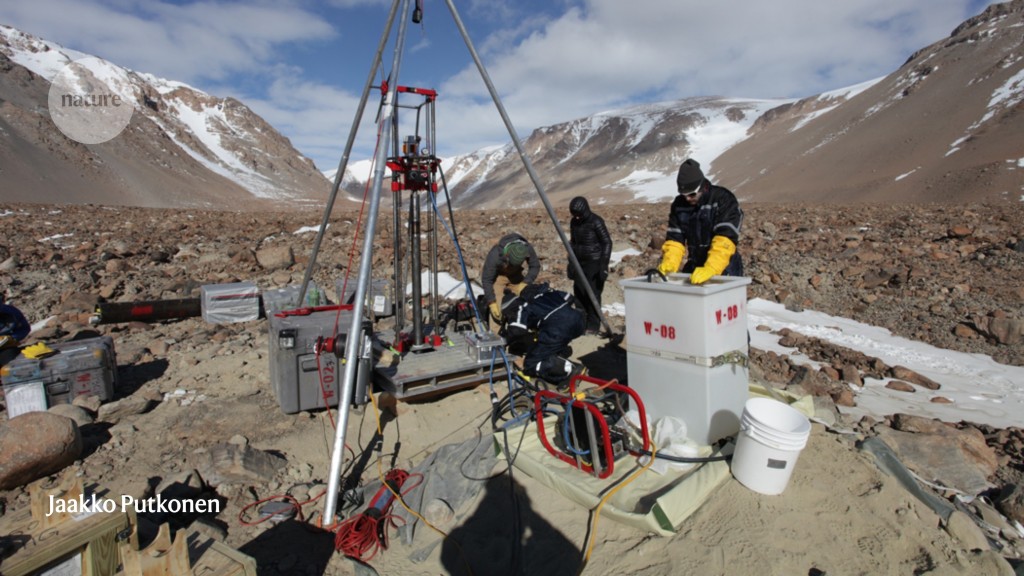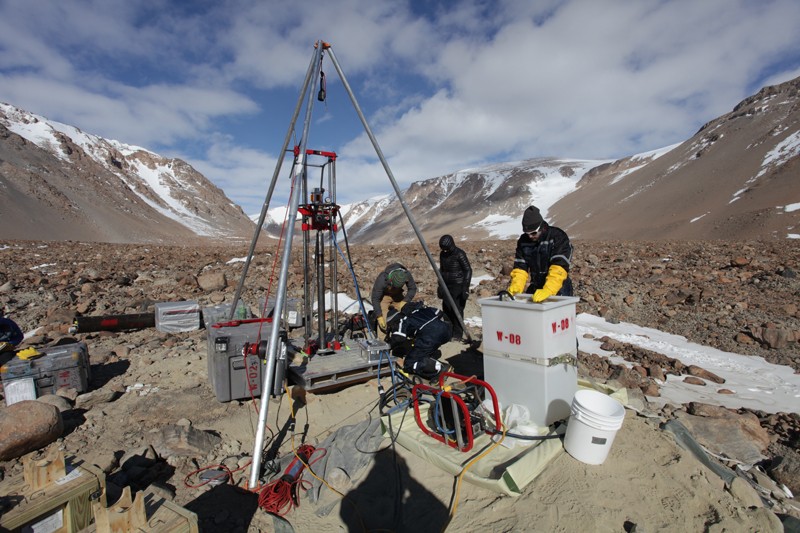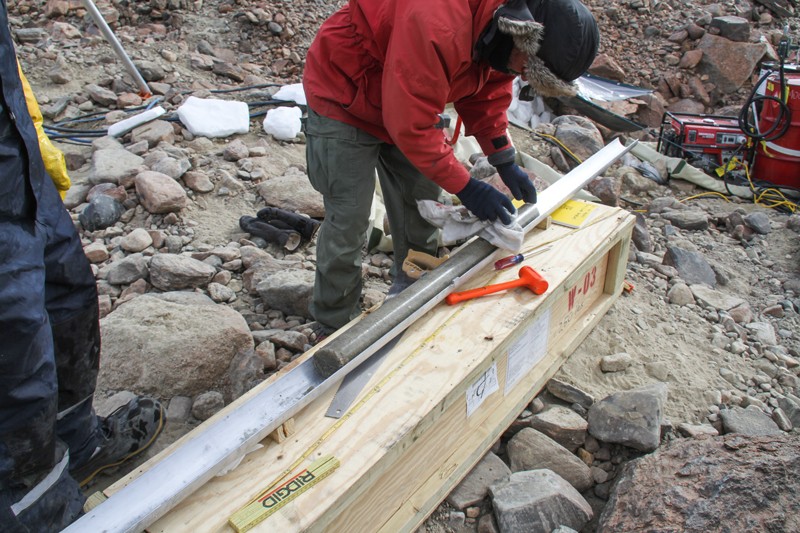Ice in places such as Antarctica acts like a time capsule: its ancient, trapped air bubbles provide snapshots of Earth’s atmosphere from millennia ago. Scientists have been hunting for increasingly older ice to extend the planet’s climate record — and one team might have just struck gold.
Researchers have unearthed a nearly 10-metre-long, sediment-filled ice core from Ong Valley in the Transantarctic Mountains, which separate eastern and western Antarctica. They estimate that the ice is up to 5 million years old — possibly the oldest ever recovered. The method used to measure the core’s age, published in The Cryosphere on 15 July1, might pave the way for research on other, older ice samples.
Most scientific ice cores are being collected from sites in eastern Antarctica, where ice has been deposited more cleanly — layer by layer from precipitation — than in Ong Valley. Several international teams are racing to extract the oldest continuous ice cores from these more orderly deposits deep underground, hoping to produce seamless timelines of atmospheric conditions that extend to about 1.5 million years ago.
The new method, however, could make it possible to date even older ice samples, deposited by glaciers, that are easier to access because they are closer to the surface. That’s the view of lead author Marie Bergelin, a glacial geologist who was part of the Ong Valley ice project while at the University of North Dakota in Grand Forks. Instead of looking deep underground, Bergelin asked, “Where else can we potentially find old ice? Where else can we go and find unique deposits?”
Putting numbers to ice
Drilling deeply for continuous ice cores costs millions of dollars and can take more than a decade of planning and fieldwork. Seeking old ice that doesn’t require as much of an investment, Bergelin and her colleagues settled on Ong Valley because previous estimates2 suggested that ice buried below one of its glacial drifts — rock material transported by a glacier — is more than one million years old. After glaciers slid into Ong Valley, their surface ice began sublimating — turning into water vapour. That left behind a protective blanket of rock material with preserved ice underneath.
Ong Valley’s sediment-filled ice probably can’t provide the detailed climate record that continuous cores can. But it might still yield new information.
The researchers collected their ice core during the 2017–18 field season, choosing an extraction site far from any areas of rockfall that could have contaminated the sample. On the basis of what they know about how ice in this region was deposited, they developed a model of how rare isotopes of beryllium, aluminium and neon accumulated in the ice’s debris over time. High-energy cosmic rays from outer space collide with rock material at or near the surface to create these isotopes. After comparing the model’s predictions with the measured isotope profile in the 10-metre-long ice core, they were able to estimate that some of the ice, up to a certain depth, was about 3 million years old.
Below that depth, isotope concentrations were much higher than expected, leading the team to conclude that two separate ice masses sit stacked on top of each other in this part of Ong Valley. They estimate the older, deeper one to be between 4.3 and 5.1 million years old.
“They’re actually putting some numbers to this ice that we haven’t been able to do before, so that’s very exciting,” says Alia Lesnek, a glacial geologist at the City University of New York.
Other researchers express uncertainty about the results because data that Bergelin and colleagues didn’t collect, such as carbon-isotope levels, could yield different ages. Scientists also wonder whether the model can be adapted for ice beyond Ong Valley’s.
Bergelin says that measuring three isotopes should be more than enough to draw conclusions, because most studies use only one or two — and the isotope carbon-14 decays too quickly to date ice that is millions of years old. She contends that the model can be applied to other Antarctic regions with similar, isolated and buried ice masses.
Still, scientists are excited about the age of the ice and what that means for future research. The study provides “very strong evidence that ice cores or ice samples can be preserved for 3 or 4 million years”, says Yuzhen Yan, a paleoclimatologist who in 2019 reported3 an Antarctic ice core that is 2.7 million years old, while he was at Princeton University in New Jersey. “This opens a new possibility for future drilling operations.”
Drilling deep
Although Ong Valley’s ancient ice sits conveniently close to the surface, international teams searching for old ice that is part of continuous cores must drill hundreds to thousands of metres into Antarctica’s frozen depths — nearly to bedrock.
Currently, the oldest continuous ice core goes back 800,000 years into the climate record. But scientists want an uninterrupted environmental record dating back to a period about one million years ago, when a major shift in Earth’s climate occurred and the pace of ice-age cycles slowed. Understanding why this sudden change happened might hint at what today’s warming climate will bring.
Some projects have already begun drilling. Among these are Russia’s VOICE project and Beyond EPICA — a collaboration between 10 European countries. Others, including efforts by Australia and Japan, will start in the next few years.
“The goal is to get multiple ice cores from different parts of Antarctica to ensure the record,” says Kenji Kawamura, a paleoclimatologist at the National Institute of Polar Research in Tokyo, who leads Japan’s project. “So it’s not possible with just one nation, or just one group.”
Drilling nearly to bedrock will be “pushing the limits of technology”, so duplicate records will also help to verify the data recovered, says Joel Pedro, an ice-core paleoclimatologist at the Australian Antarctic Division in Hobart, who leads the Million Year Ice Core project.
Meanwhile, Bergelin and her colleagues already have their ice, which might shed light on a period extending back about 2.5 to 5 million years, when global temperatures and carbon dioxide levels were higher than today’s. They think this time on Earth could also hold lessons for how the planet is now responding to human-caused climate change.
“We have found and dated this ice to be some of the oldest,” Bergelin says. “Now, the future is to look at what we can get out of it.”








More News
Star Formation Shut Down by Multiphase Gas Outflow in a Galaxy at a Redshift of 2.45 – Nature
Garden-variety fungus is an expert at environmental clean-ups
Air-travel climate-change emissions detailed for nearly 200 nations